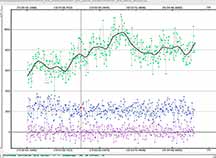
This event is low probability. It's decently high probability if you drive to Nevada, but this event was advertised too late to try and plan for such an expedition. As it turns out, it looks to be clear and decent weather and might have been do-able as a van trip. But - too late.
However, it has a moon which is well within the possibility of seeing. Odds are still low, but we're only 1 asteroid diameter away and within the moonlet's orbit.
Alt=24, Az=272, so this is not visible from my carport. Will have to get up and drive somewhere.
As a rough comparison, it’s ~584 km from Klamath Falls to, say, Cabrillo Observatory, so it’s worth a shot. To the north, 623 km from Klamath Falls is north of Wenachee, WA (the actual normal to the path is somewhat more- I was just snapping a line in Google Earth).Semi-major axis 623.5±10 kmEccentricity 0.31±0.03 based on [7].
I did not try this one. Odds very low and at 5am, and given my chronic sleep deprivation, I skipped it. The Hektor path was definitely too far away. But Hektor has a moon but of unknown position. The moonlet was believed to be about 12km, leading to a 0.7 s duration, which should still be detectable. Clouded out at bed time. Heavy cirrus came in. Kirk tried anyway. The cirrus is evident in his reference star, largely calibrated out for the target star, but increased noise.
No apparent event. Target star was relatively bright at 11.6m but because of clouds 32x integration was necessary. My location was out of the predicted path for Hektor, but observed to possibly detect its satellite, Skamandrios. Predicted duration for main body was 10.11s at 2.0m drop. PyOTE detectability tool reported an event as short as 1.650s would likely be detectable. This was a Lucky Star event, I have uploaded my data to their occultation portal.
 |